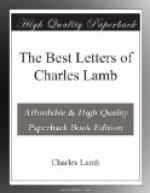The London “Times” of September 26, 1796, contained the following paragraph:—
“On Friday afternoon the coroner and a jury sat on the body of a lady in the neighborhood of Holborn, who died in consequence of a wound from her daughter the preceding day. It appeared by the evidence adduced that while the family were preparing for dinner, the young lady seized a case-knife lying on the table, and in a menacing manner pursued a little girl, her apprentice, round the room. On the calls of her infirm mother to forbear, she renounced her first object, and with loud shrieks approached her parent. The child, by her cries, quickly brought up the landlord of the house, but too late. [7] The dreadful scene presented him the mother lifeless, pierced to the heart, on a chair, her daughter yet wildly standing over her with the fatal knife, and the old man, her father, weeping by her side, himself bleeding at the forehead from the effects of a severe blow he received from one of the forks she had been madly hurling about the room.
“For a few days prior to this, the family had observed some symptoms of insanity in her, which had so much increased on the Wednesday evening that her brother, early the next morning, went to Dr. Pitcairn; but that gentleman was not at home.
“The jury of course brought in their verdict,—Lunacy.”
I need not supply the omitted names of the actors in this harrowing scene. Mary Lamb was at once placed in the Asylum at Hoxton, and the victim of her frenzy was laid to rest in the churchyard of St. Andrew’s, Holborn. It became necessary for Charles and his father to make an immediate change of residence, and they took lodgings at Pentonville. There is a pregnant sentence in one of Lamb’s letters that flashes with the vividness of lightning into the darkest recesses of those early troubles and embarrassments. “We are,” he wrote to Coleridge, “in a manner marked.”
Charles Lamb after some weeks obtained the release of his sister from the Hoxton Asylum by formally undertaking her future guardianship,—a charge which was borne, until Death released the compact, with a steadfastness, a cheerful renunciation of what men regard as the crowning blessings of manhood, [8] that has shed a halo more radiant even than that of his genius about the figure—it was “small and mean,” said sprightly Mrs. Mathews—of the India House clerk.
As already stated, the mania that had once attacked Charles never returned; but from the side of Mary Lamb this grimmest of spectres never departed. “Mary A is again from home;” “Mary is fallen ill again:” how often do such tear-fraught phrases—tenderly veiled, lest! some chance might bring them to the eye of the blameless sufferer—recur in the Letters! Brother and sister were ever on the watch for the symptoms premonitory of the return of this “their sorrow’s crown of sorrows.” Upon their little holiday excursions, says Talfourd, a strait-waistcoat, carefully packed by Miss Lamb herself, was their constant companion. Charles Lloyd relates that he once met them slowly pacing together a little footpath in Hoxton fields, both weeping bitterly, and found on joining them that they were taking their solemn way to the old asylum. Thus, upon this guiltless pair were visited the sins of their fathers.




